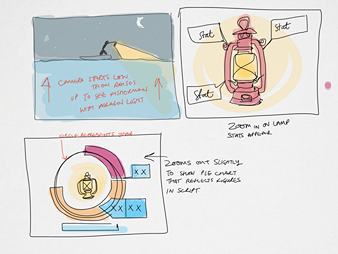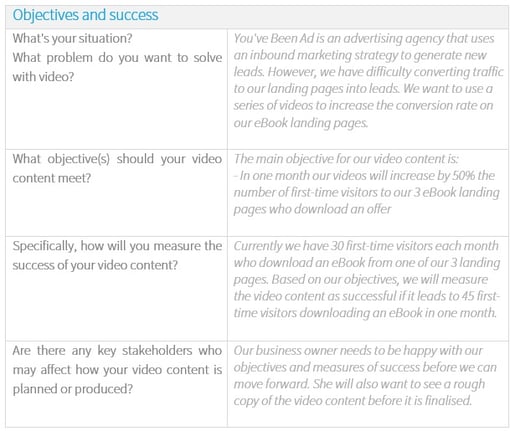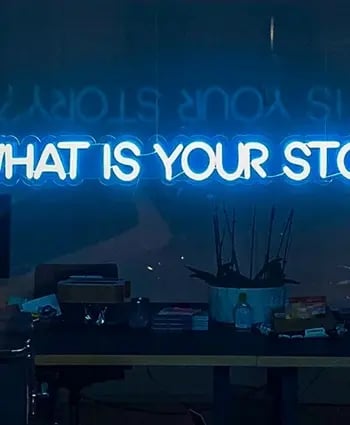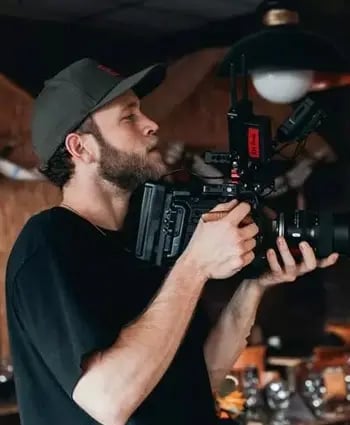Video Production Made Simple: A Step-by-Step Guide
Feeling confused about video? Our step-by-step guide will help you feel empowered when it comes to Corporate Video Production.
Taking the time to plan your corporate video production projects, can have a big impact on their success. Well thought out content not only targets the right people but also drives the results you want potential clients to take when they see it.
To see the engaging and results driven videos we create for yourself: click here.
Our guide will show you how to outline your objectives, get insights into your target audience, focus on your core message, plan the specifics & write a video production brief.
I have a marketing friend.
(In fact I have several marketing friends, but this anecdote is about just one of them.)
She recently produced a piece of video content as part of her marketing strategy for the first time.
How do you think she felt? Excited? Inspired? Enthusiastic?
Nope.
Well, she was feeling all of those a little bit, but mostly she was feeling scared.
Overwhelmed and out of her depth.
Even though she's an experienced and talented marketer, she froze at the thought of video. She simply didn't know where to begin.
Step-by-Step Video Production
Sound familiar? This isn't an isolated case. It's more common that you might think.
In fact, you might even have experienced it yourself.
Video content isn't the big scary monster a lot of digital marketers, internal comms experts and communicators of all kinds have convinced themselves it is.
Producing it is a lot like any other kind of content, just with its own peculiarities.
This post will guide you through the corporate video production process step by step, with tips for every stage, so you can stop feeling scared and start feeling empowered and enthused.
1. Solidify your Objectives
First things first. Everything begins with your ultimate goal for your video content.
Just like any other type of content, you can't reach your aim without first deciding on what it is.
Whether you want to use video to raise awareness of your brand or encourage your staff to adopt a new internal process, you need to decide on SMART video objectives.
That means making sure your objectives are:
- Specific
- Measurable
- Achievable
- Relevant
- Time-bound
If you're struggling to define what you want to achieve with video content, try thinking about problems or issues in your business that could be solved with video.
You might also find our free Video Objectives Template useful to help pin down your objectives.
Lastly, consider what measures of success you'll need to track to work out how quickly you achieve your objectives. There's no point in setting objectives if you can't measure them.
2. Research Your Audience
The success of any video project rests on your understanding of your target audience.
Unless you have a firm understanding of who your audience are, what they like and how they think, you're going to have a hard time creating video content that appeals to and engages them.
That's why you need to conduct thorough research into your target audience. From there you can base all of the creative decisions involved in video production on solid fact and research.
If you already have personas as part of your marketing or communications strategy, now's the time to use them.
Don't just focus on the demographics of your target audience like their age, gender and location.
Try to gain insight into your audience: what are their most common problems? What do they really connect with? Conducing interviews, asking for feedback and listening to the questions your target audience ask online are all good ways to learn more about them.
 This image may or may not be an accurate representation of your target audience.
This image may or may not be an accurate representation of your target audience.
3. Decide on Your Core Message
Now that you've done solid research on your target audience, let's return to your objectives.
Keep your end goal in mind: what action do your audience need to take to make it happen?
Essentially:
- What do you want your audience to do after watching your video?
- What do you want them to think?
- How do you want them to feel?
This is probably simpler than you think. For example, if your objective for your video content is to increase sign-ups to a free trial, you'll want your audience to... sign up to that free trial after watching. You might want them to feel excited, and to think that your service will help them to organise their busy schedule.
Once you've got your answer, you need to turn it into one thing your audience need to know to encourage them to think, feel and act that way.
This will become the core message of your video content.
So following on from the example above, the core message of your video might be: our service helps you to organise your busy schedule quickly and on the go.
Sometimes you'll need multiple messages in your video, but try to keep them to no more than a few. The more messages your video content contains, the greater the risk of confusing your audience.
4. Build a Video Strategy
The next step is to create a solid strategy for your video content.
This involves planning a number of things, including:
- How you will create your video content, in house or externally.
- How you will target your audience and distribute your video so it reaches them.
- How you will reuse and repurpose your video for improved ROI.
- How you will achieve all of this within your budget and deadline.
Basically, a good strategy is vital to the success of your video.
That's a lot of pressure, but don't feel overwhelmed. Building a strategy for video is very similar to building a strategy for any other kind of campaign.
You may still have a nagging feel that your inexperience in video means your strategy is built more on guesswork than knowledge. Unfortunately, this is something that can only really be overcome by learning as much as you can and then trying it for yourself.
If you've already decided to work externally to produce your video, an experienced video agency can be brought in at the strategy stage to help you put these plans in place.
5. Write a Video Production Brief
Finally, a video production brief needs to be created before pre-production can commence. This document will serve as a guide during the whole production process to ensure nothing goes off-track.
The brief should include all the research and information you've collected so far:
- Your video objective(s).
- Your target audience and any insights you have into them.
- What you want your audience to feel, think and do.
- The core message(s) behind your video.
- Your budget and deadline.
Use our simple video production brief template (plus examples) to fill in all necessary information.
An example of a video brief, take from our free template.
Make sure your brief contains all the important data you have gathered during the planning stage. It should be as detailed as it needs to be without being overly long. Again, a good video agency will be able to help you complete an effective video brief.
Pre-Production
6. Develop the Creative Approach
Taking your video brief as a starting point, it's time to come up with a creative approach. Essentially, this is the idea or concept of your video content.
For example, the creative concept behind that Dollar Shave Club video is: watch a business founder as he gives a comedically bad tour of his factory and convinces the audience to buy his razor blades.
The aim is to build upon insights into your target audience, and to use them to create an interesting and engaging way of presenting your core message that will help achieve your objectives.
As with any kind of brainstorming, this process should begin with lots of potential ideas that are then whittled down to only the very best. Any and all ideas should be permitted initially, no matter how outlandish or unusual they may be.
A creative approach to video can be almost anything, but the best:
- Take inspiration from other successful videos.
- Are unique enough from other videos to stand out.
- Reflect a true insight into the target audience in question.
- Are not afraid to be different or strange, if the approach fits the brief.
That's the key: whatever creative approach you decide on, it must be backed up by your video brief.
7. Write a Script
The creative approach picked in the last step should heavily influence the writing of the script for your video content.
This is an important, specialised task that should ideally be left to an expert.
After all, the script will serve as the blueprint for your video (along with the storyboard in the next step). Everything that makes it into the script at this stage will almost certainly make it into the final video content too.
Any great script needs to:
- Be human and natural.
- Be engaging, interesting and emotive.
- Be interesting to your target audience.
- Be simple and easy to understand.
- Be short, sweet and concise.
- Sound good when read aloud.
- Get across all the necessary information.
- Convey your core message.
A script can also include details about specific locations, actors, props, and actions if that level of detail is necessary, for example, if you are hiring actors to dramatise a training scenario.
8. Create a Storyboard or Scamp
Once the script is complete, you may also want to create a storyboard or scamp (a rough drawn mock up of an idea), though this isn't always necessary.
You might find it useful to be able to visualise how your video will be shot. A storyboard or scamp can give a clear visual portrayal of lighting, colouring, framing, transitions and many other aspects of film. This can be achieved through drawing, stock images, or even stock footage.
 A scamp from one of our video projects.
A scamp from one of our video projects.
A storyboard will likely show every shot of the video in detail, which will then be followed closely during production.
On the other hand, a scamp will be less likely to be followed to the letter, but will rather serve as visual inspiration to inform the look and feel of the video.
Your reliance on a storyboard or scamp during the production depends on the type and complexity of the video, as well as personal preference. Many videos simply use a detailed script when it comes time to film.
9. Plan and Schedule the Shoot
This is the last hurdle before filming itself can begin.
In this part of pre-production, everything related to the shoot of the video is organised and scheduled.
This long list of planning includes:
- Scouting and securing a location (indoors or outdoors).
- Getting a crew together: directors, camera operators, lighting and sound technicians, runners.
- Casting actors or presenters (either professionals or people on your team).
- Organising all equipment.
- Ensuring makeup and costume is present if needed.
- Acquiring all necessary licenses and permissions.
- Putting in place contingency plans if anything goes wrong.
- Writing the call sheet, or timed plan of filming.
Generally this process should be handled by an experienced producer. If you're working with a video agency to produce your video, this is the step you'll need to have least involvement in.
Production
10. Shoot the Footage
On the actual days of filming, you probably won't need to be present, unless you're appearing in the video, of course.
Film shoots are best left to the professionals.
The reason you create such a detailed brief and script (and storyboard) is so that the director knows precisely what they're doing on the shoot. Nothing is left to chance. However, if you or a representative wishes to watch the filming take place, this shouldn't be a problem.
The director will ensure that:
- Everyone appearing on camera is relaxed and gives their best performance.
- The video is well-lit, well-shot and well-framed.
- Enough footage is filmed to make the editing process as easy as possible.
- The script and storyboard are followed closely.
Have faith in the director, the producer and the crew. This is their speciality, and they will deliver to a high standard.
Post-Production
11. Edit the Video Content
Once all filming is complete, it's time to begin editing.
This step will need to be handled by a skilled editor. They will examine many hours worth of footage and select the best takes to use in the final video. They will then cut the film together according to the script and storyboard, so that your core message shines through.
Good edits:
- Are as short as possible while containing all the necessary information.
- Are cut in a way that makes the video easy to understand and follow.
- Are visually interesting.
- Use B-roll to liven up long shots.
- Get across the core message of the video brief and script.
- Include a CTA to encourage your audience to take action.
During the editing process you might want to request alterations or revisions. Be sure to agree this beforehand with your editor or the video agency you're working with, to avoid misunderstandings.
When giving feedback on your video, be clear, specific and ensure everything your request stays on-brief. Always allow a reasonable amount of time for your changes to be made.
12. Add Graphics and Special Effects
This won't apply to every video production, but sometimes you may want generated graphics and other special effects to help your video come to life.
Anything from a background transposed over green screen to animated characters to graphs displaying facts and figures can be created with special effects.
This stage might be completed at the same time as editing, or immediately afterwards.
(It depends on the video agency and the particular process they follow.)
However, just like the editing of the footage, all additional graphics will follow the script and storyboard closely to ensure they blend in seamlessly with the rest of the video.
13. Mix Music and Soundtrack
It's not only the visuals that make a video great. Audio must be accounted for too.
A good edit must work specifically with the music of the video, to achieve the overall desired effect in the target audience. Sound effects and other noises can also be added to create a more realistic and engaging sound mix.
Not every corporate video needs a famous music track, but subtle background music can help enliven almost any video.
Any music included in in your video should:
- Complement the mood and tone of the video.
- Help to get across your core message.
- Be appropriate for your target audience.
- Match the pace of the edit.
Generally you'll have to buy a license or pay fees for the music you want in your video, which a producer can also handle.
14. Record the Voiceover
Hand in hand with the music of your video is the voiceover.
Again, a voiceover isn't necessary for every video. But if you've chosen to use one in your corporate video, it's important that it works with the footage just as well as any music.
Make sure you hire a voiceover artist who:
- Is appealing to your target audience.
- Can read the script in a way that reinforces your core message.
- Has an emotive, pleasant-sounding voice.
When the voiceover is being recorded, you may well want to try several different takes. This will give the editor more flexibility when matching the voiceover to the footage to make sure the whole edit feels cohesive.
Final Touches & Distribution
15. Format and Host the Video
Once you're happy with the final cut of your video it can be formatted.
This involves the video being turned into the correct format and quality for its various uses, as outlined in the video production brief. This might mean a HD version for use at a conference, or a more compressed and shortened teaser to be placed on social media.
After this is complete, your video will also need to be hosted online so it can be shared and distributed according to your strategy.
Depending on your plan of distribution and your budget, you will have several options when it comes to hosting your video.
These include:
- Hosting the video on a paid platform like Wistia, with access to advanced analytics and optimisation.
- Hosting the video on a free channel like YouTube, with fewer video metrics and less control.
- Self-hosting the video on your own server.
Generally it's recommended to host your video content on a paid platform where you have full control over how and where you it is distributed. This will also allow you to more accurately measure the success of your video.
16. Set up Analytics and Results
Speaking of measuring success, to do so you'll need to ensure all the right video metrics are in place.
Return to the very first step of the whole video production process: your video objectives.
Make sure that you can track these objectives now that your video content is finished. If not you'll have difficulty working out if you're achieved your goal, and by how much.
If you've decided to host your video on a paid hosting platform like Wistia, the measures of success you want to track will most likely already be in place. However, if you're hosting on a free video channel like YouTube you may have to use a separate analytics tool to find the data you require.
This is a vital part of the whole production process, so don't just assume you'll be able to track what you need. If you can't measure the success of your video content once it's out in the world, you'll never learn from your experience so you can make improvements in the future.
17. Distribute and Promote Your Video
We've reached the final step. Once your video content is filmed, edited, formatted and hosted, you can at last begin to distribute and promote it according to your video strategy.
As always, keep in mind your core message and your target audience.
You'll need to market your video where your audience will see it, and in a way that makes your core message clear. This should all tie into your larger marketing strategy for other types of content.
There are many ways to distribute your video, and they will vary depending on your audience.
Some of the most common are:
- Social media seeding on sites where your target audience spend time.
- Using SEO to optimise your video for relevant search keywords.
- Reaching out to your audience's key influencers to help spread the video.
- Engaging in PR to promote your video content.
- Paying for ad spend to show the video on television or in cinemas.
- Incorporating the video into your email marketing.
And that's it, you're done. Now the video has been spread to your target audience, it's time to use analytics to determine the success of your entire campaign ready for the next piece of video content.
What About Animation?
The 17-step process outlined above works fine for corporate video production if you're looking to create a live-action video, but it looks a little different when producing an animation.
(What's the difference between the two and how do you choose? This post will fill you in.)
Here's how the animation process differs:
- The planning and distribution sections of the process are pretty much identical.
- In the pre-production section there's no need to organise a shoot.
- And the production section merges into post-production, as the entire animation is created from scratch using specialist software rather than needing to film footage.
Apart from that, follow the exact same steps and processes for creating an animation as you would a live-action video.
Round Up: Making Video Production Even Smoother
Now you know the steps it takes to produce a corporate video, you're ready to dive into your first video project without fear.
But before you go, here are my last tips on making video production as smooth as possible:
- Be organised. Do your research in good time. If you want to use your logo in the video, get a high quality version ready to save rushing around at the last minute.
- Remember that the perfect is the enemy of the good. Don't spend forever on endless revisions. Create a video that you're happy with and that fulfils the brief, and then let it loose!
- If you don't have the expertise, resources or time to produce video content in-house, look externally. Find the right video agency for you and let them guide you through the process.
- If you're working with professionals, trust them and let them do their jobs. You chose them for a reason after all. So if they tell you something isn't working in your script, they're most likely right.
- Keep learning and trying new things. The only way anyone becomes an expert in video is through practice and experience.
Written by Jonathan English CEO for Venture Videos — a full-service video production agency that specialises in producing creative videos & campaigns that get real results.






